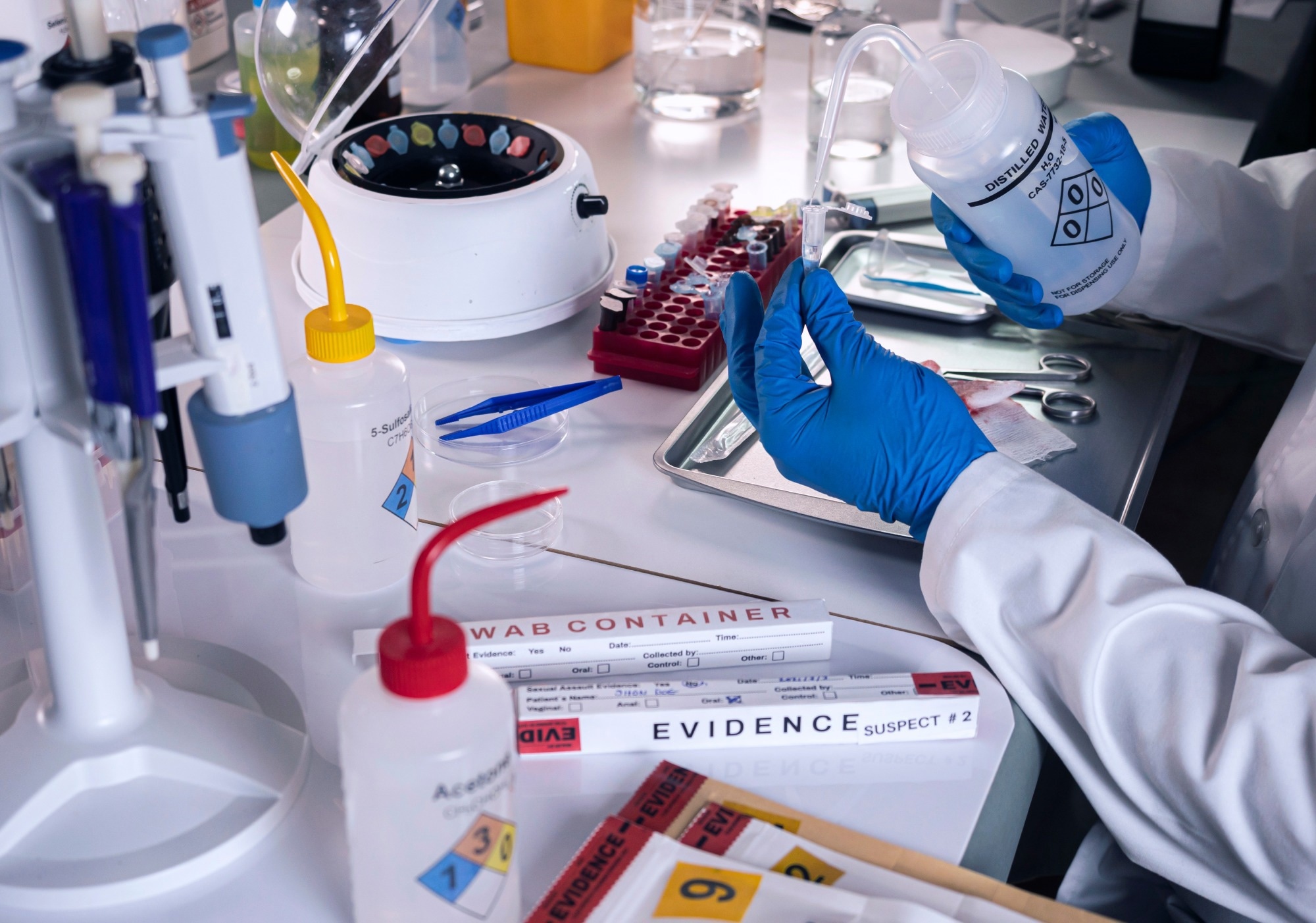Forensic serology is the analysis of bodily fluids, such as blood, semen, and saliva, during legal and criminal investigations. It helps identify and evaluate biological evidence at crime scenes, often playing a key role before more advanced tests are run.
Today, DNA profiling offers unmatched accuracy in linking biological material to individuals. So why does serology still matter?

Image Credit: digicomphoto/Shutterstock.com
Despite advances in DNA technology, serology remains vital, especially for quickly screening evidence, guiding further testing, and offering insights when DNA isn’t an option.
The Basics of Serology
Serology is the study of bodily fluids. It helps determine what they are and who, or what, they came from.
Serology was one of the earliest biological tools used in forensic science. In the early 1900s, investigators used blood typing, like the ABO and Rh systems, to narrow down suspects. This approach, known as serological exclusion, helped rule people out based on blood type.
DNA profiling, which became widespread in the 1980s, introduced inclusion—the ability to match a biological sample to a specific individual with high precision. While DNA offers greater specificity, serology is still used in the investigative process, especially in the early stages of evidence screening.
Download your PDF copy now!
Techniques Used in Forensic Serology
Forensic serology starts with presumptive testing, a fast, sensitive way to screen for the possible presence of bodily fluids. These tests don’t confirm what the fluid is, but they help investigators decide what to test further.
For example, the Kastle-Meyer test is used to detect potential bloodstains. It turns pink when hemoglobin causes an oxidation reaction in phenolphthalein, though other oxidizing substances can produce false positives.[1]
Semen can be screened using the acid phosphatase test, which turns purple in the presence of high levels of this enzyme. However, acid phosphatase can appear in other bodily fluids, too. Saliva is often identified using the Phadebas test, which detects alpha-amylase, an enzyme abundant in saliva but also present in smaller amounts in other fluids, leading to possible cross-reactions.[2]
After presumptive screening, confirmatory tests are used to verify the identity of a bodily fluid with greater specificity. These tests are typically immunological or microscopic.
Blood confirmation often involves antibody-based assays. While older methods used anti-human hemoglobin precipitin, modern tools like the ABAcard® HemaTrace® offer a faster, more user-friendly alternative using immunochromatographic strips.
For semen, confirmatory testing usually involves identifying sperm cells under a microscope using tissue stains. However, in cases where sperm is absent, the RSID™-Semen test can detect semenogelin, a seminal fluid protein. Other tests may target acid phosphatase or prostate-specific antigen (PSA) to confirm the presence of semen.[3]
Determining whether a sample is human or animal is another critical step. One method used is the Ouchterlony immunodiffusion test, where antibodies and antigens interact in a gel. If a match is present, visible lines form, indicating species specificity.
While no longer central to forensic analysis, blood typing using ABO and Rh systems can still support investigations, especially when DNA is unavailable or when multiple individuals may have contributed to a sample. These tests can include or exclude people based on biological compatibility and can even be applied to fluids like saliva.[4]
Edvotek Informational Video: Forensic Blood Typing
To detect trace or hidden blood, chemical enhancement techniques are used. Luminol and Bluestar® react with iron in hemoglobin to produce a chemiluminescent glow, revealing stains that may have been cleaned or are invisible to the naked eye. Bluestar® is often preferred for its stronger and longer-lasting chemical luminescence.
Alternative light sources (ALS) are also widely used. They help visualize fluids like semen and saliva, which fluoresce under specific wavelengths. ALS tools are fast, easy to use, and cost-effective, making them valuable during early evidence screening.[5]
The Modern Role of Serology in the DNA Era: Why It Still Matters
In today’s forensic landscape, DNA is often seen as the end goal, but serology remains essential for understanding the context of a crime. Knowing what type of bodily fluid is present—and where—can help reconstruct events and support or challenge witness statements.
In many cases, identifying a fluid is meaningful in itself. For example, detecting saliva on skin or semen on clothing can support charges, even when DNA can't be recovered or interpreted.
Serological methods are also faster, cheaper, and more accessible than DNA profiling, particularly useful in labs with limited resources or when quick decisions are needed. In this way, serology doesn’t just support DNA—it adds depth, speed, and practical value to the investigative process.
Explore more innovations in forensic science:
References and Further Reading
- Lalonde, W. & Millman, J. S. (2019). Case study: Loss of Kastle-Meyer test specificity on jeans. Science & Justice, 59, 359-361.https://doi.org/10.1016/j.scijus.2018.12.002. Available: https://www.sciencedirect.com/science/article/pii/S1355030618302405
- Wornes, D. J., Speers, S. J. & Murakami, J. A. (2018). The evaluation and validation of Phadebas(®) paper as a presumptive screening tool for saliva on forensic exhibits. Forensic Sci Int, 288, 81-88.10.1016/j.forsciint.2018.03.049. https://www.sciencedirect.com/science/article/abs/pii/S0379073818301555
- Breuer, J., Thomas, A., Geyer, H. & Thevis, M. (2022). Probing for the presence of semenogelin in human urine by immunological and chromatographic-mass spectrometric methods in the context of sports drug testing. Anal Sci Adv, 3, 21-28.10.1002/ansa.202100058. https://chemistry-europe.onlinelibrary.wiley.com/doi/full/10.1002/ansa.202100058.
- Das, M., Banerjee, A., Samanta, J., Bhunia, B. B., Mozumder, S. & Ramalingam, K. (2023). ABO Blood Grouping and Rhesus Factor Determination From Dental Pulp Tissue: A Forensic Research. Cureus, 15, e43386.10.7759/cureus.43386. https://pmc.ncbi.nlm.nih.gov/articles/PMC10495078/
- Vandewoestyne, M., Lepez, T., Van Hoofstat, D. & Deforce, D. (2015). Evaluation of a Visualization Assay for Blood on Forensic Evidence. Journal of Forensic Sciences, 60, 707-711.https://doi.org/10.1111/1556-4029.12720. Available: https://onlinelibrary.wiley.com/doi/abs/10.1111/1556-4029.12720
Last Updated: May 6, 2025